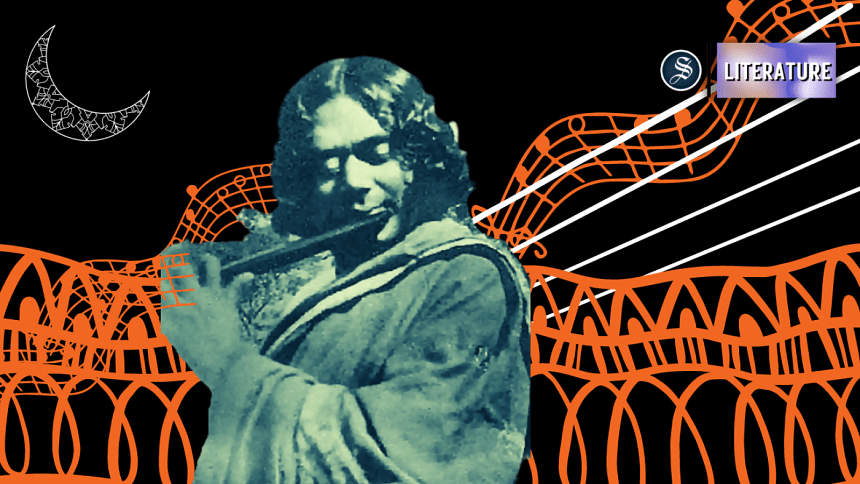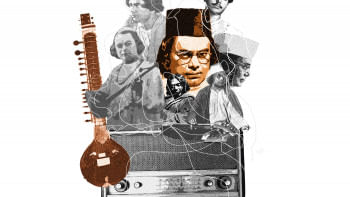‘O mon Ramjan er ei rojar sheshe elo khushir Eid’: On Nazrul and his ode to Eid

Eid-ul-Fitr in this country is incomplete without Nazrul's famous song playing on national television. Only after we have seen the sliced moon in the sky and heard the lines, "O Mon Romjaner Oi Rojar Sheshe Elo Khushir Eid", do we know for sure that Eid has arrived.
This song is like an ode to Bengali Eid-ul-Fitr, which has stayed with us for about a century now. Almost 90 years ago, in the year 1931, Kazi Nazrul Islam mused it into the very fabric of Bengali culture. Its initial release was during the colonial period, in a declining time of Muslim literature and culture. It was definitely not easy to write such a piece for Muslim people at that time.
The idea of an Islamic cultural song had sprung from the mind of Nazrul's disciple, Abbasuddin Ahmed, who was a singer of Nazrul geeti. The history of this song can be traced in his memoirs, Amar Dinlipi O Amar Shilpi Jiboner Kotha. Following the rule of the British Empire, the Bengali Musolman was greatly deprived from the light of literacy. Contemporary Indian society was developing through the hands of the privileged Hindu class. It had alienated the existence of Muslims in the Bengal delta. In this drought of absence, Abbasuddin wanted to gift the Muslims of Bengal with a song of their own. A 'kawali' for the commoners, which was to be sung during the festivals and occasions of celebrations. Following Abbas' idea, Nazrul decided to write a song for Eid-ul-Fitr, a song which tends to connect the rich and the poor, the urban and the rural in a bond of fraternity. It was only after Abbasuddin's solicitation with Bhagabati Babu, the owner of The Gramophone Company, that Nazrul came up with the lyric.
It took only 30 minutes of rigorous composing. Little did he know that this half an hour would immortalise him for centuries.
The early 1900's was a time of Islamic decline in this region, when 'Shemasangeet' became a popular genre for song writers. It evoked the audience and also had monetary value, which made the producers focus on them. While Nazrul produced multiple 'Shemasangeet', the idea of an Islamic ode vacillated his mind. Following its recording by Abbasuddin, the song aired two months later in February 1932, just a few days before Eid. After its release, 'O Mon Romjaner Oi Rojar Sheshe' never left its place from the tongues of Bengali Musolmans. People kept it alive via oration till the day it became a cultural component to the Bengali Muslim society.
Similar to many other songs by Kazi Nazrul Islam, this song shares a glimpse of his vision and spirituality. The song is a call for liberation from the shackles of class, community and difference. It is an invitation towards the peace and resilience that Islam has to offer. While its chorus became the most familiar tone for Bengali Muslims on the occasion of Eid, its verses sent the message of fraternity and liberation. Starting with the arrival of Eid, the verse opens with a call to give oneself up to the order of Allah. It is a note of forgiveness, a cry to become new again. It is a chant for Musolmans to wake up from their deep sleep, to celebrate and be a part of this great occasion.
The second and third verses of the song narrate the sacrifices of Muslim martyrs in the field of war. It is an offering towards universal fraternity, a tone of united melody among the people of the world. A song of love that stoops humanity towards the unity of Muslim ummah. Like many other Nazrul songs, the Ode of Eid in the later verse shifts into the depiction of class and the difference among them. It compares 'roja' to the daily life of forsaken people and encourages an offering that can only eliminate this difference. It is only the purity of mind that will bring people closer to each other. Only this purity of closeness at heart will be accepted by Hajrat, the last prophet of Muslim Ummah.
The last verse dictates a note of sacrifice and forgiveness. It tells listeners to create a mosque of love with the broken stones that were thrown at them. Nazrul, as a writer of the people, always knew that only a sense of compassion could establish harmony between divided societies. It was through this song that Nazrul tried to illustrate the meaning of Eid, which consisted of sacrifice and perseverance. Forgiveness in the end can start a new day, a new beginning. Thus, the song becomes a historical document of Bengali Muslims preaching spiritual unity, the abolition of the difference of class and wealth. As the chant of the chorus follows, Eid becomes an umbrella of joy, happiness and gratitude for people all around the world.
Written almost a century ago, Nazrul's song till today adheres to the cultural conscience of Bengali Muslim society. Although the song was experimentally produced, it reached the hearts of the entire Bengal. It became a document of Bengali Islamic culture, a narrative of Muslim brothers and sisters. During the cultural drought of Bengali Musolman, Nazrul became their primary instrument of melody, raining his creativity, often with Islamic songs and ghazals. Quickly after its release, this song became a country wide chant, a connection between difference and distinction—which made both Nazrul and Abbasuddin highly popular in the sub-continent. Today, almost a century after its release, this song is still a big part of our Eid celebration. It is an Ode, a sermon, and an anthem for Bengali Muslims upon the occasion of Eid-ul-Fitr.
KM Arefin is a contributor.

 For all latest news, follow The Daily Star's Google News channel.
For all latest news, follow The Daily Star's Google News channel. 








Comments